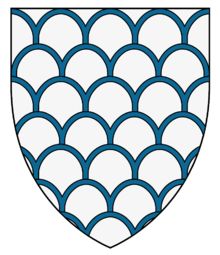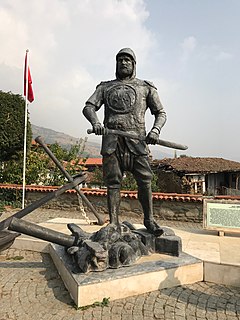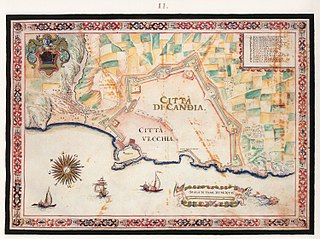
The Third Battle of the Dardanelles in the Sixth Ottoman-Venetian War took place on 26 and 27 June 1656 inside the Dardanelles Strait. The battle was a clear victory for Venice and the Knights Hospitaller over the Ottoman Empire, although their commander, Lorenzo Marcello, was killed on the first day.

Gattilusio was a powerful Genoese family who controlled a number of possessions in the northern Aegean from 1355 until the mid 15th century. Anthony Luttrell has pointed out that this family had developed close connections to the Byzantine ruling house of the Palaiologos—"four successive generations of Gattilusio married into the Palaiologos family, two to emperors' daughters, one to an emperor, and one to a despot who later became an emperor"—which could explain their repeated involvement in Byzantine affairs. The Gattilusi were Lords of Lesbos from 1355 to 1462 and Lords of Aenus from 1376 to 1456.
This battle was fought on 10 July 1651, with some minor fighting on 8 July, south of Naxos in the Greek Islands, between Venetian and Turkish sailing ship/galley forces. It was a Venetian victory.

Martino Zaccaria was the Lord of Chios from 1314 to 1329, ruler of several other Aegean islands, and baron of Veligosti–Damala and Chalandritsa in the Principality of Achaea. He distinguished himself in the fight against Turkish corsairs in the Aegean Sea, and received the title of "King and Despot of Asia Minor" from the titular Latin Emperor, Philip II. He was deposed from his rule of Chios by a Byzantine expedition in 1329, and imprisoned in Constantinople until 1337. Martino then returned to Italy, where he was named the Genoese ambassador to the Holy See. In 1343 he was named commander of the Papal squadron in the Smyrniote crusade against Umur Bey, ruler of the Emirate of Aydin, and participated in the storming of Smyrna in October 1344. He was killed, along with several other of the crusade's leaders, in a Turkish attack on 17 January 1345.

In 1480 the small Knights Hospitaller garrison of Rhodes withstood an attack of the Ottoman Empire.

Umur Ghazi, Ghazi Umur, or Umur The Lion, also known as Umur Pasha was the second Emir of Aydin, on the Aegean cost of Anatolia, from 1334 to 1348. He was famous for his naval expeditions. As a writer, poet and patron of the arts and sciences, Kalila wa-Dimna was first translated to Persian during his reign. Umur was described in an epic chronicle Düstürnâme-i Enverî, written by poet and historian Enveri during the reign of Sultan Mehmed II, as "the 'Lion of God' leading a just and holy war of conquest against the 'miscreants' and infidel Christians". According to an unreliable but colorful source, two Venetian ambassadors remarked that he was immensely fat with a stomach "like a wine casket". They had found him wearing silks, drinking almond milk and eating eggs with spices from a golden spoon. Umur Ghazi was a loyal ally and friend of Emperor John Cantacuzenus of the Byzantine Empire and provided him with material aid during his military campaigns, especially during the Byzantine civil war of 1341–1347. He apparently sent 380 ships and 28,000 men to aid him in the conflict and besieged the city of Demotika in Thrace, Greece. The emperor John reportedly mourned his death. At the height of its power, the Emirate of Aydin possessed 350 ships and 15,000 men.

The Cretan War, also known as the War of Candia or the Fifth Ottoman–Venetian War, was a conflict between the Republic of Venice and her allies against the Ottoman Empire and the Barbary States, because it was largely fought over the island of Crete, Venice's largest and richest overseas possession. The war lasted from 1645 to 1669 and was fought in Crete, especially in the city of Candia, and in numerous naval engagements and raids around the Aegean Sea, with Dalmatia providing a secondary theater of operations.

The First Ottoman–Venetian War was fought between the Republic of Venice and her allies and the Ottoman Empire from 1463 to 1479. Fought shortly after the capture of Constantinople and the remnants of the Byzantine Empire by the Ottomans, it resulted in the loss of several Venetian holdings in Albania and Greece, most importantly the island of Negroponte (Euboea), which had been a Venetian protectorate for centuries. The war also saw the rapid expansion of the Ottoman navy, which became able to challenge the Venetians and the Knights Hospitaller for supremacy in the Aegean Sea. In the closing years of the war, however, the Republic managed to recoup its losses by the de facto acquisition of the Crusader Kingdom of Cyprus.

The Smyrniote crusades (1343–1351) were two Crusades sent by Pope Clement VI against the Emirate of Aydin under Umur Beg which had as their principal target the coastal city of Smyrna in Asia Minor.

The siege of Corfu took place on 8 July – 21 August 1716, when the Ottoman Empire besieged the city of Corfu, on the namesake island, then held by the Republic of Venice. The siege was part of the Seventh Ottoman–Venetian War, and, coming in the aftermath of the lightning conquest of the Morea by the Ottoman forces in the previous year, was a major success for Venice, representing its last major military success and allowing it to preserve its rule over the Ionian Islands.
Henry of Asti was the titular Roman Catholic patriarch of Constantinople from 1339 and bishop of Negroponte in Frankish Greece. His fame rests on his leadership of the first Smyrniote crusade (1342–45), on which he died.
The Battle of Chios was a naval battle fought off the shore of the eastern Aegean island of Chios between a Latin Christian—mainly Hospitaller—fleet and a Turkish fleet from the Aydinid emirate. The Christian fleet was resoundingly victorious, but for the Aydinids, who had been engaging in piracy since the collapse of Byzantine power, it was only a temporary setback in their rise to prominence.

Pietro Zeno was the Venetian captain and bailiff of Negroponte (1331–33) and one of the leaders of the Smyrniote crusade (1343–45).
The Hospitaller conquest of Rhodes took place in 1306–1310. The Knights Hospitaller, led by Grand Master Foulques de Villaret, landed on the island in summer 1306 and quickly conquered most of it except for the city of Rhodes, which remained in Byzantine hands. Emperor Andronikos II Palaiologos sent reinforcements, which allowed the city to repel the initial Hospitaller attacks, and persevere until it was captured on 15 August 1310. The Hospitallers transferred their base to the island, which became the centre of their activities until it was conquered by the Ottoman Empire in 1522.
The Battle of Amorgos occurred in 1312 between the fleets of the Knights Hospitaller and of the Turkish beylik of Menteshe. The battle was a Hospitaller victory, but both sides suffered heavy losses.
The Battle of Pallene occurred in 1344 between the fleets of a Latin Christian league and Turkish raiders, at the Pallene Peninsula in northern Greece.

The Battle of Megara occurred in 1359 between an alliance of the Christian states of southern Greece, and of a Turkish raiding fleet. The battle was a victory for the allies.
The Battle of Adramyttion occurred in autumn 1334 between the fleets of a Christian naval league, headed by the Republic of Venice and the Knights Hospitaller, and of the Turkish beylik of Karasi. The battle was a Christian victory.
The Battle of Gallipoli occurred on 29 May 1416 between a squadron of the Venetian navy and the fleet of the Ottoman Empire off the Ottoman naval base of Gallipoli. The battle was the main episode of a brief conflict between the two powers, resulting from Ottoman attacks against Venetian possessions and shipping in the Aegean Sea in late 1415. The Venetian fleet, under Pietro Loredan, was charged with transporting Venetian envoys to the Sultan, but was authorized to attack if the Ottomans refused to negotiate. The subsequent events are known chiefly from a letter written by Loredan after the battle. The Ottomans exchanged fire with the Venetian ships as soon as the Venetian fleet approached Gallipoli, forcing the Venetians to withdraw.

The siege of Rhodes was a military engagement involving the Knights Hospitaller and Mamluk Sultanate. The Mamluk fleet landed on the island of Rhodes on 10 August 1444, besieging its citadel. Clashes took place on the western walls of the city and at the Mandraki harbor. On 18 September 1444, the Mamluks departed from the island and lifted the siege.









